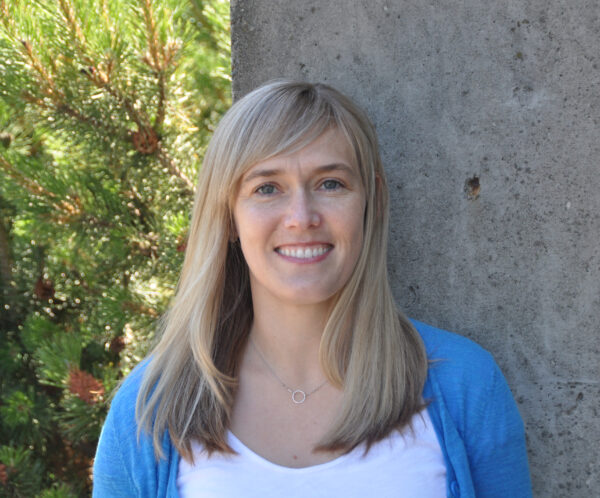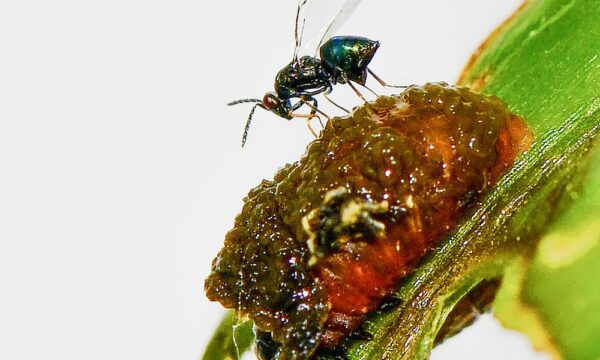Meet Jennifer Andreas, who has collaborated with CABI on a number of biological control projects since 2000, in this profile originally published by the North American Invasive Species Management Association (NAISMA).
Field Dispatch: Jennifer Andreas
Jennifer Andreas stays busy in biocontrol as director of Washington State University’s Integrated Weed Control Project, lead for the Flowering Rush Biocontrol Consortium, and co-chair of the NAISMA Biocontrol Committee.
Under many challenges, thousands of people are controlling invasive species every day. They know that without someone guarding their forests, fields and waters, North America would lose its food web, agricultural heritage, and native species that fuel the life of this continent. Many invasive species professionals — whether in biocontrol, mechanical management, or outreach — feel like they’re on their own, and NAISMA is here to connect them to one another. The NAISMA Field Dispatches chronicle the daily work, concerns and success of invasive species managers and leaders across North America.

Meet Jennifer Andreas. Jennifer is the director of Washington State University’s Integrated Weed Control Project and co-chair of the NAISMA Biocontrol Committee. We’re excited to introduce her to you on the eve of the NAISMA Biocontrol Summit.
How did you get interested in invasive species and biocontrol?
I initially went to college for landscape design and quickly realized it wasn’t for me, however I fell in love with my entomology and invasive plant courses and knew I wanted to pursue a career in that direction.
When I learned about the practice of using a plant’s natural enemies to manage invasions (classical biological weed control), it felt like a really valuable tool and a perfect marriage of my interests.
What challenges or concerns do you have regarding invasive plant management? Does anything keep you up at night?
Like a lot of us working in invasive species, I worry we are losing the battle but those are really only in my darker moments. More often I worry that we aren’t reaching enough of the public or conveying the issues of invasive species well enough to encourage the behavior and policy changes that would lead to long-term and substantive resources and impacts.
What (or who) has helped you in your career or your current work?
There are so many! I started my career working as a co-op student with Rosemarie De Clerck-Floate at Agriculture and Agri-Food Canada during my undergraduate degree and Mark Schwarzlaender at the University of Idaho for my Master’s of Science degree.
Since beginning my work with WSU, I am so fortunate to work with an incredible community of weed biocontrol and invasive plant partners. My program is entirely grant funded, so I am endlessly grateful to the U.S. Forest Service, WA State Department of Agriculture and a variety of other federal, tribal, state, and county entities who provide support for my program.
What outreach have you found to be successful in your part of the world?
I work closely with the Washington State Noxious Weed Control Board and WA State Department of Agriculture to develop a variety of outreach materials. Our most popular materials are the New Invader postcards that we develop for the general public to increase visibility of high priority species in Washington. Our program website has also been really popular and I am excited that we will soon have a new one.

Lightning Round! What’s your…
Favorite tool: Biocontrol, of course!
Favorite invasive species: Flowering rush. You have to respect a weed that is besting us at almost every turn.
Least favorite invasive species: Yellow starthistle. It’s just so painful!
Favorite native species: Showy milkweed (Asclepias speciosa)
Favorite natural area: How can I choose? Let’s go with the Makah Tribal Lands
Coffee or tea? Tea in Canada and coffee in the states.
You were among the North American contacts with CABI in a recently article titled, “Invasive weeds in America’s Western states: restoring balance using biological control.” The article paints the big picture of species and their biocontrol counterparts. But I’m sure there’s a great story behind each one. Is there a biocontrol program that you find especially exciting?
As the lead for the Flowering Rush Biocontrol Consortium, I find that project particularly interesting. With any new proposed biocontrol program, you never know what kind of support, financial and otherwise, you will receive from other people but I have been so impressed by how this group has pulled together and found enough funding to move the project forward incredibly quickly. In a short number of years we already have three potential biocontrol agents identified, testing is underway, and we hope to submit a petition for field release for one rhizome/leaf-feeding weevil in early 2021. It really demonstrates how multiple partners joining forces can work toward a common goal and make things happen.
What is one of your favorite biocontrol success stories?
The stem-mining weevil for Dalmatian toadflax.

CABI is an international not-for-profit with experts in invasive biocontrol research and development. How did you get involved with CABI, and what was your work in Canada? Has working across international borders influenced your perspective on invasive species management stateside in the U.S.?
I was introduced to CABI when I worked at Agriculture and Agri-Food Canada as a student. I primarily worked on the houndstongue biocontrol project with both AAFC and CABI. I went over to CABI Switzerland in the summer of 2000 to work as a summer student and learn a different side of biocontrol research. I have been connected with them ever since on a number of projects, particularly flowering rush.
Working with biocontrol and invasive species in Canada and the U.S. has given me an appreciation for how varied the challenges we all face are and how complicated the solutions can be. One of the biggest differences I see between the two countries in terms of biocontrol, is the time it takes to for a biocontrol agent to be approved for release. Canada has a much faster process. It is the envy of many land managers and weed biocontrol practitioners. 😊
Is there anything else you’d like to share from the NAISMA biocontrol committee?
We are planning a Biocontrol Summit October 28. We will have speakers providing updates about biocontrol projects from around North America and developing projects from our European partners.
Where would you like to see the WSU Integrated Weed Control Project in 5-10 years?
LOL! Existing! With only grant funding, the future is always uncertain.
I would like the see the IWCP continuing to work with partners regionally, nationally and internationally. Ideally, we will be releasing and evaluating biocontrol agents for flowering rush. I am also passionate about building a better understanding of biocontrol within the general public and regulatory agencies in order to increase support and use of this important tool.
Related News & Blogs
Biological control in action: Zambia’s field days on fighting fall armyworm
Experts from CABI recently held two field days and an expo in Zambia, showcasing innovative approaches to pest management to 584 farmers, agro-dealers and other stakeholders to help raise awareness of approaches to tackle the invasive fall armyworm (Sp…
11 June 2025




